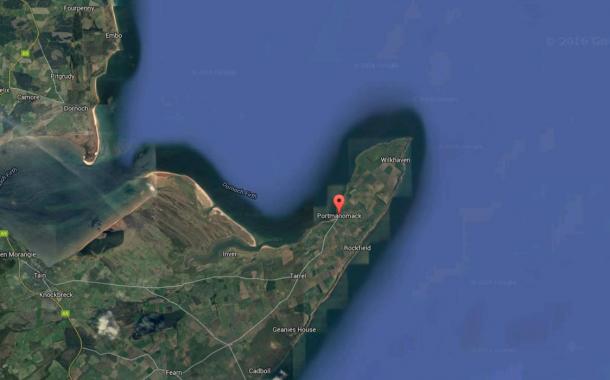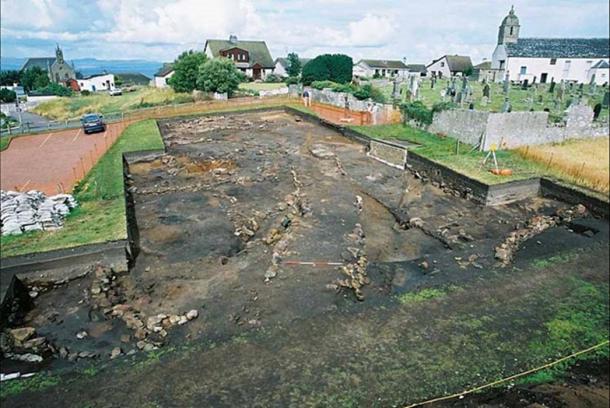
The Golden Age of the Christian Picts: Evidence for Religious Production at Portmahomack
Situated on the edge of the Tarbat peninsula on the northeastern coast of Scotland, Portmahomack carries a legacy of a long buried Golden Age of religious industry that was devastatingly altered by the arrival of the Norsemen in the 9th century. Considered one of the most important monastic sites of the Dark Ages, i.e., 4th-9th centuries (Figure 1), Portmahomack was one of various monasteries of early medieval Scotland. Attributed to the people of Pictland, a culture unique against the early medieval backdrop of migrating Germanic tribes sweeping through southeast Britain, Portmahomack remains one of the most extensively excavated monastic sites of the Picts currently known to scholars.

Figure 1. Map depicting the location of Portmahomack, (Google Maps)
Monasteries came to Britain and Ireland from the Mediterranean east, the concept likely transmitted when the first manuscripts arrived in the west not long after the east converted. All that survives of these manuscripts is "a page from a late Roman book said to have belonged to St. Augustine", however the practice was undoubtedly translated to the clerics in Britain and Ireland around the same time as the manuscripts were received in the 5th and 6th centuries AD. A monastery is best defined as "collections of buildings, cemeteries and working areas within an enclosure… grafted on to the existing network of regional, tribally based sees". The key to defining an early medieval monastery often lies in its proximity to towns and people, as it weighed solitary and tedious meditative practices above all else. Though the early monasteries of Britain and Ireland were not as sophisticated as those of the east, by the 9th century they became highly organized. Portmahomack's lifetime falls right in the midst of these different structural designs, leading one to wonder again on the possible Norse influence on Portmahomack. Regardless, for the purposes of simplicity, the word "monastery" or "monastic" will be used to describe the location throughout.
- Archaeologists in Scotland investigate the mystery of the Rhynie Man
- Discovery of Pictish Fort Reveals Iron Age Look-Out post for Sea Raiders
Dated to the 6th century, the monastery at Portmahomack was most extensively excavated between 1994 and 2007 by archaeologist Martin Carver. Carver's excavation team revealed a Pictish goldmine, providing a plethora of information for what enterprises monasteries engaged in for both secular and ecclesiastical purposes. Various stages of an early medieval church were uncovered in Carver's delineated Sector 4, and within the remains sculptured stones similar to the Pictish symbol stones have been uncovered. Evidence for artisan crafts have been plentiful, revealing invaluable indications of vellum production and sculpture, iron- and glass-working in Sectors 2 and 1 (respectively) from (8th century); those same production areas were later repurposed in Period 3 (9th-11th centuries) with bronze-smiths and agricultural farming, respectively.
The Site
As Martin Carver's excavation is most prevalent, it is his description and breakdown of the site that will be utilized for the purposes of this paper. Carver divides the artisan area of Portmahomack into the Northern Quarter (located in Sector 2) and the Southern Quarter (located in Sector 1), the two sites separated by a valley which the monks themselves had dammed c.590-720 CE. The Parchment-Maker's Hall (Figure 2) was the site of vellum production in the Northern Quarter, while the metallurgists worked in the Smith's Hall in Sector 1 (Figure 3). Both sites share an overlap of radiocarbon dates—the Northern Quarter primarily active 650-780 CE and the Southern Quarter between 610-770 CE—leading scholars plausibly deduce the starting date and "Golden Age" of religious craftsmanship at Portmahomack.

Figure 2. Sector 2, location of vellum production. (Martin Carver)

Figure 3. Sector 1, location of the Smith's Hall. (Martin Carver)
It has been inferred by archaeologists that the Northern Quarter was the site of vellum production. The monks had paved a road through the Northern Quarter all the way to a terraced wall in the valley. This road both provided the monks easy access to fresh water while it simultaneously split the northern sector into two distinctive work sites. One side of the road was "dedicated to hide-processing: the preparation of leather (west), with probably the slaughter of the cattle" on the other side, in the east. As the east side of the road consisted predominately of cattle bones, it is generally agreed that during the second period at Portmahomack, cattle were raised both for gastronomical and ecclesiastical purposes—that is, the east side was where the cattle were stripped of their hides for vellum production and meat for feeding the community. The west side of the road, however, is described by Carver as having had a timber building with a hearth as evidenced by features such as "a fragmentary wall and a ditch, both providing a curving boundary to the north, and a southern wall…of rubble set in a matrix of silky sand". There was also a "slab-lined tank at its center" and, due to the pebble discovered around it, was hypothesized as belonging "to the earliest…part of the sequence" and likely used for "the washing of bloody hides, trimming, soaking in an astringent synthesized from shells, de-hairing, de-fleshing, thinning…preserving, stretching on frames, pouncing and smoothing". This leather was lightened through the use of seaweed rather than the traditionally used lime (capable of making chalk), as the latter was not available to the monks on the Tarbat peninsula.

Tarbat Ness from the south across the Moray Firth (CC BY-SA 2.0)
Contemporary with the production of vellum, archaeologists found evidence of other ecclesiastical crafts besides parchment making were discovered—including but not limited to iron-forging, glasswork, woodwork and sculpture. Found within the same work-space as the forging of iron a cleverly carved low relief sculpture called the "Calf Stone" (8th century) was uncovered, and it—along with other sculptural finds, such as the "Apostle Stone" and the "Boar Stone" discovered in the church proper and the nearby cross-slabs—revealed stone artists were active within the monastery and carving ecclesiastical images. That Portmahomack appears to have had its own sculpture workshop serves to further the theory of religious centrality during Period 2, particularly when examined in conjunction with the vellum workshop. Though no actual manuscripts have been found, the Pictish symbol stones have often been considered the closest evidence of possible Pictish manuscripts, as the art of Class II stones (Figure 4.1) most closely resembles that of Irish and Northumbrian manuscripts, as seen on a carpet page or author page of the Book of Kells dated around 800 AD (Figure 4.2-left) or of the 7th-8th century Book of Durrow (Figure 4.2-right). Thus, when viewing the various crafts of Period 2 together, Portmahomack provides as the closest concrete evidence in support of the likelihood of Pictish manuscripts or, at least, the intention and capability to create them.

Figure 4.1. The Aberlemno Kirkyard Stone, Class II Pictish stone (CC BY-SA 2.0)

Figure 4.2. Left: Book of Kells, carpet page, folio 33 v2, 9th century; (Public Domain) Right: Matthew, Book of Durrow, author page, 7th-8th centuries (Public Domain).
These crafts from Period 2 indicate a monastic emphasis on transforming ideas into ideologies, accomplished when said ideas are put into practice. This is the primary distinction between the artisan crafts of Period 2 and Period 3, the latter to be discussed in Part 2 of this work. During this second period at Portmahomack, the strongest indicators of a monastic community over a mere site of religious fervor lie in the vellum and sculptural trades of the craftsmen. There were those who raised and slaughtered cattle; those who created parchment from their hides; and there were prominent men of artistic talent who worked in stone and other media (bronze, iron, etc.) to create tools, belongings and/or emblems of the monks' religious dedication and purpose as well as those who worked in iron creating objects for both everyday life and for religious purposes.
- Painted Pictish Pebbles - Sling-shots or charm stones?
- 14th Century Painting Depicts Limb Transplant That Occurred 1,500 Years Ago
As will be seen in the next section, the production of parchment is not practiced in Period 3, and the other crafts simultaneously cease have an obvious religious purpose. Thus the items in Period 2 can be almost definitively determined as ecclesiastical first and foremost. Whatever other purposes they might have served were likely secondary based on emphasis.
Top image: Abbey of Kells - Scanned from Treasures of Irish Art. (Public Domain)
By Riley Winters
References
Adomnan & Sharpe, R., 1995. Life of St. Columba, London: Penguin Classics.
Allen, J.R. & Anderson, J., 1903. The Early Christian Monuments of Scotland 1993rd ed., Balgavies: Pinkfoot Press.
Burn, A.R., 1969. Holy Men on Islands in Pre-Christian Britain. Glasgow Archaeological Journal, 1, pp.2–6.
Carver, M., 2004. An Iona of the East : the early-medieval monastery at Portmahomack, Tarbat Ness. Medieval Archaeology, 48(1), pp.1–30. Available at: http://dx.doi.org/10.1179/007660904225022780.
Carver, M., 2009. Early Scottish monasteries and prehistory: A preliminary dialogue. Scottish Historical Review, 88(2), pp.332–351.
Carver, M., 2003. The Cross Goes North: Processes of Conversion in Northern Europe AD 300-1300, York: York Medieval Press.
Clarke, D., Blackwell, A. & Goldberg, M., 2013. Early Medieval Scotland: Individuals, Communities and Ideas, Edinburgh: National Museums of Scotland.
Driscoll, S., 1998. Picts and Prehistory: Cultural resource management in early medieval Scotland. World Archaeology, 30, pp.142–158.
Fraser, I. ed., 208AD. The Pictish Symbol Stones of Scotland, Edinburgh: RCAHMS.
Harden, J., 1995. A potential archaeological context for the early Christian sculptured stones from Tarbat, Easter Ross. In C. Bourke, ed. From the Isles of the North: Early Medieval Art in Ireland and Britain. Belfast: HMSO, pp. 221–226.
Henderson, G. & Henderson, I., 2004. The Art of the Picts: Sculpture and Metalwork in Early Medieval Scotland, London: Thames & Hudson, Ltd.
Higgitt, J., 1982. The Pictish Latin Inscription at Tarbat in Ross-shire. PSAS, 112, pp.300–321.
Hudson, B., 2014. The Picts (The Peoples of Europe), Hoboken: Wiley-Blackwell.
Jones, R.H. & Ralston, I., 2010. Artefacts and sites: a long and problematic relationship. Scottish Archaeological Journal, 32(1), pp.1–13.
Kirby, M. et al., 2009. Argyll Excavations of a Monastic Settlement and Medieval Church Site at Killevin , Crarae Gardens , Mid Argyll. Scottish Archaeological Journal, 31(1/2), pp.61–105.
Mac Airt, S. and Mac Niocaill, G. (eds). 1983. The Annals of Ulster (to A.D. 1131). Dublin: Dublin Institute for Advanced Studies.
Sharpe, R., 2008. In quest of Pictish manuscripts. Innes Review, 59(2), pp.145–167. Available at: http://www.euppublishing.com/doi/abs/10.3366/E0020157X08000267.
Sipolla, C., 2013. Between History and Economics. Antiquity, 83, pp.1136–1150.
Veitch, K., 1997. The Columban church in Northern Britain 664-717: A reassessment. PSAS, 127, pp.627–647.
Wainwright, F.T., 1955. The Problem of the Picts, London: Nelson.















